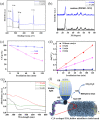C,N co-doped TiO2 hollow nanofibers coated stainless steel meshes for oil/water separation and visible light-driven degradation of pollutants
- PMID: 37029148
- PMCID: PMC10082082
- DOI: 10.1038/s41598-023-28992-4
C,N co-doped TiO2 hollow nanofibers coated stainless steel meshes for oil/water separation and visible light-driven degradation of pollutants
Abstract
Complex pollutants are discharging and accumulating in rivers and oceans, requiring a coupled strategy to resolve pollutants efficiently. A novel method is proposed to treat multiple pollutants with C,N co-doped TiO2 hollow nanofibers coated stainless steel meshes which can realize efficient oil/water separation and visible light-drove dyes photodegradation. The poly(divinylbenzene-co-vinylbenzene chloride), P(DVB-co-VBC), nanofibers are generated by precipitate cationic polymerization on the mesh framework, following with quaternization by triethylamine for N doping. Then, TiO2 is coated on the polymeric nanofibers via in-situ sol-gel process of tetrabutyl titanate. The functional mesh coated with C,N co-doped TiO2 hollow nanofibers is obtained after calcination under nitrogen atmosphere. The resultant mesh demonstrates superhydrophilic/underwater superoleophobic property which is promising in oil/water separation. More importantly, the C,N co-doped TiO2 hollow nanofibers endow the mesh with high photodegradation ability to dyes under visible light. This work draws an affordable but high-performance multifunctional mesh for potential applications in wastewater treatment.
© 2023. The Author(s).
Conflict of interest statement
The authors declare no competing interests.
Figures








Similar articles
-
Efficient removal of oil from oil contaminated water by superhydrophilic and underwater superoleophobic nano/micro structured TiO2 nanofibers coated mesh.Chemosphere. 2017 Mar;171:134-141. doi: 10.1016/j.chemosphere.2016.12.031. Epub 2016 Dec 10. Chemosphere. 2017. PMID: 28013074
-
Zwitterionic Polymer Hairy Coating onto Mesh toward Easy Oil/Water Separation.Macromol Rapid Commun. 2022 Apr;43(8):e2200016. doi: 10.1002/marc.202200016. Epub 2022 Mar 16. Macromol Rapid Commun. 2022. PMID: 35218095
-
Micro/Nanoscale Structured Superhydrophilic and Underwater Superoleophobic Hybrid-Coated Mesh for High-Efficiency Oil/Water Separation.Polymers (Basel). 2020 Jun 19;12(6):1378. doi: 10.3390/polym12061378. Polymers (Basel). 2020. PMID: 32575503 Free PMC article.
-
Fabrication of Photo-Responsive Mesh Membrane with Surface-Engineered Wettability for Oil-Water Separation and Photocatalytic Degradation of Organic Pollutants.Membranes (Basel). 2023 Mar 4;13(3):302. doi: 10.3390/membranes13030302. Membranes (Basel). 2023. PMID: 36984689 Free PMC article.
-
Ultrafast separation of oil/water mixtures with layered double hydroxide coated stainless steel meshes (LDH-SSMs).J Hazard Mater. 2020 Nov 5;398:122862. doi: 10.1016/j.jhazmat.2020.122862. Epub 2020 May 13. J Hazard Mater. 2020. PMID: 32473327
References
-
- Li H, Boufadel MC. Long-term persistence of oil from the exxon valdez spill in two-layer beaches. Nat. Geosci. 2010;3(2):96–99. doi: 10.1038/ngeo749. - DOI
-
- Cooper CM, McCall J, Stokes SC, McKay C, Bentley MJ, Rosenblum JS, Blewett TA, Huang Z, Miara A, Talmadge M, Evans A, Sitterley KA, Kurup P, Stokes-Draut JR, Macknick J, Borch T, Cath TY, Katz LE. Oil and gas produced water reuse: Opportunities, treatment needs, and challenges. ACS EST Eng. 2022;2(3):347–366. doi: 10.1021/acsestengg.1c00248. - DOI
-
- Di J, Li L, Wang Q, Yu J. Porous membranes with special wettabilities: Designed fabrication and emerging application. CCS Chem. 2021;3(3):2280–2297. doi: 10.31635/ccschem.020.202000457. - DOI
Grants and funding
LinkOut - more resources
Full Text Sources

